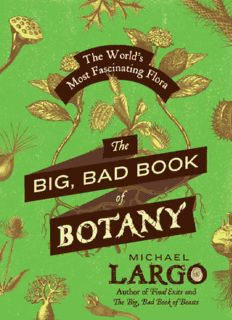
The Big, Bad Book of Botany The World's Most Fascinating Flora PDF
Preview The Big, Bad Book of Botany The World's Most Fascinating Flora
DEDICATION To Joe Largo. Thank you for your help and for being a son who makes a father proud. EPIGRAPH What is a weed? A plant whose virtues have never been discovered. —Ralph Waldo Emerson CONTENTS Dedication Epigraph Introduction A B C D E F G H I J K L M N O P Q R S T U V W X Y Z Acknowledgments Sources About the Author Also by Michael Largo Back Ad Credits Copyright About the Publisher INTRODUCTION What is green and allows you to breathe? That life-sustaining lungful of air you just took had to come from somewhere. Without plants, and the oxygen they produce, there could be no animal life on earth. These were our planet’s pioneering organisms, who first learned the tricks of adaptation to survive on our once-sterile rock, and who turned it into the vibrant, blue-green home we know today. They are both our forerunners and our contemporaries in life—but what do we really know about plants? No one has cracked the encrypted language of plants. Insects chirp, bees buzz, animals growl, hiss, hum, and even transmit low-frequency sound waves. But plants, as far as we know, never say a thing. Fields of tall summer grasses waft without agency, moving whichever way the wind blows. Roots stay where their seeds originally sprouted. A rose makes no announcement when its bud opens in full-petal bloom. Pine trees in a forest stand like silent sentries. A bent coconut palm owes its haphazard arc to the ocean winds and sea mist; it is silent on the changes its species needed to learn in order to survive where it does. There are trees living today that are estimated to be eight thousand years old, and nearly microscopic phytoplankton that live and die within an hour—but neither will divulge their history or the secrets they contain unless we look. Without plants, we would simply not be here. Plants have no brains. We can be certain they have absolutely no way to perceive this world in any way remotely similar to our view. But is there another level of “consciousness” we have yet to understand? Plants do everything possible to survive and to reproduce toward the continuation of their species. This is no easy feat, particularly as disadvantaged as plants are to alter the environment in which they find themselves. The seemingly magical biochemistry these entirely stationary organisms acquired to survive and thrive is astonishing. Much has come from looking at the chemistry within; for example, we now understand how a plant produces oxygen via photosynthesis—an amazing process we would never be able to duplicate—and there are countless other techniques plants employ that even the smartest computer could not match. The primary goal of every living organism is individual survival and the preservation of its species. As more complex plants arose, new ways to procreate came into play. Plants had to find a way to attract “helpers” to transfer male pollen to a female ovary in order to make a “baby”—what botanically we call fruits, or seeds. The collection of means they devised to accomplish this all- important process was and still is diverse. What we admire as a flower is basically a billboard, grown with the sole purpose of saying “Hey, check me out” to bees, beetles, or birds. Some enticed with sweet nectar, others chose toxins and traps, yet all methods proved to be marvelously diverse and interesting. Most of what our earliest ancestors knew of plants has been forgotten. The first attempt to catalog plants is found in sacred Indian texts from 1100 B.C., known as the Avestan Writings. Aristotle’s student Theophrastus compiled a book, Historia Plantarum, sometime during the second and third century B.C. that included information on 500 different species. The most important book about plants was written by first-century A.D. Greek physician Pedanius Dioscorides, titled (when later translated into Latin) De Materia Medica, which remained the standard and most extensive book about plants for nearly sixteen centuries. These books treated botany more like herbalism, and were meant to reveal the best plants for medical purposes. There was no science, no medicine, no pharmacology for early peoples; the kinds of things we depend on from science were found in plants, and survival depended upon knowing the properties and secrets each species held. In this book, I try to combine the reference-like quality of these early texts and the most fascinating folklore of the past, with descriptions, life cycles, advice on cultivation, and the benefits these plants provide. But more important, I hope to capture the incredible diversity of plants and marvel at the vast plant kingdom’s many wonders. We need to look at the amazing greenness about us in a new way —with not only awe and respect, but also renewed curiosity. Likewise, we must protect the incredible flora we are fortunate to still have among us, lest our own actions cause them to disappear forever.
Description: